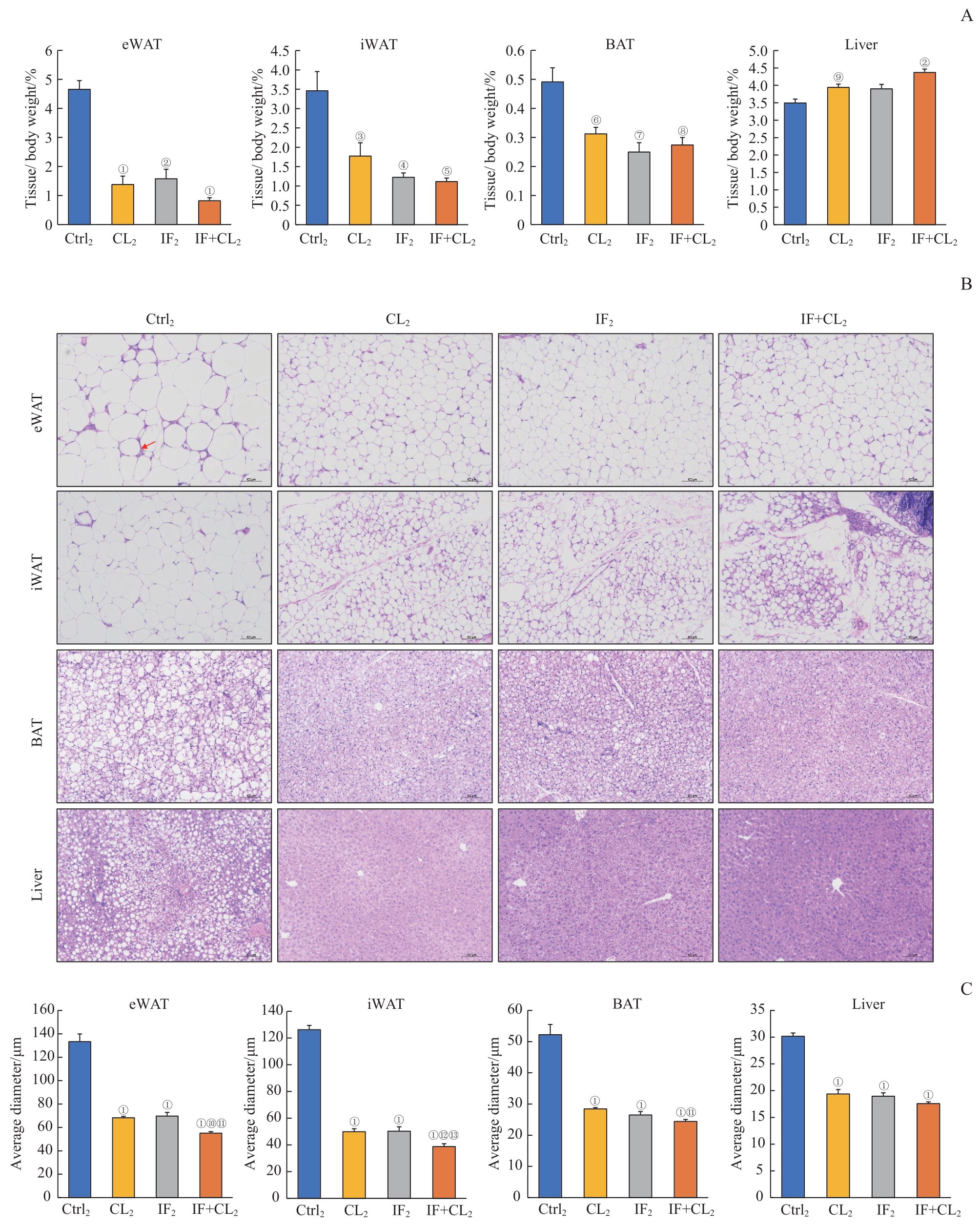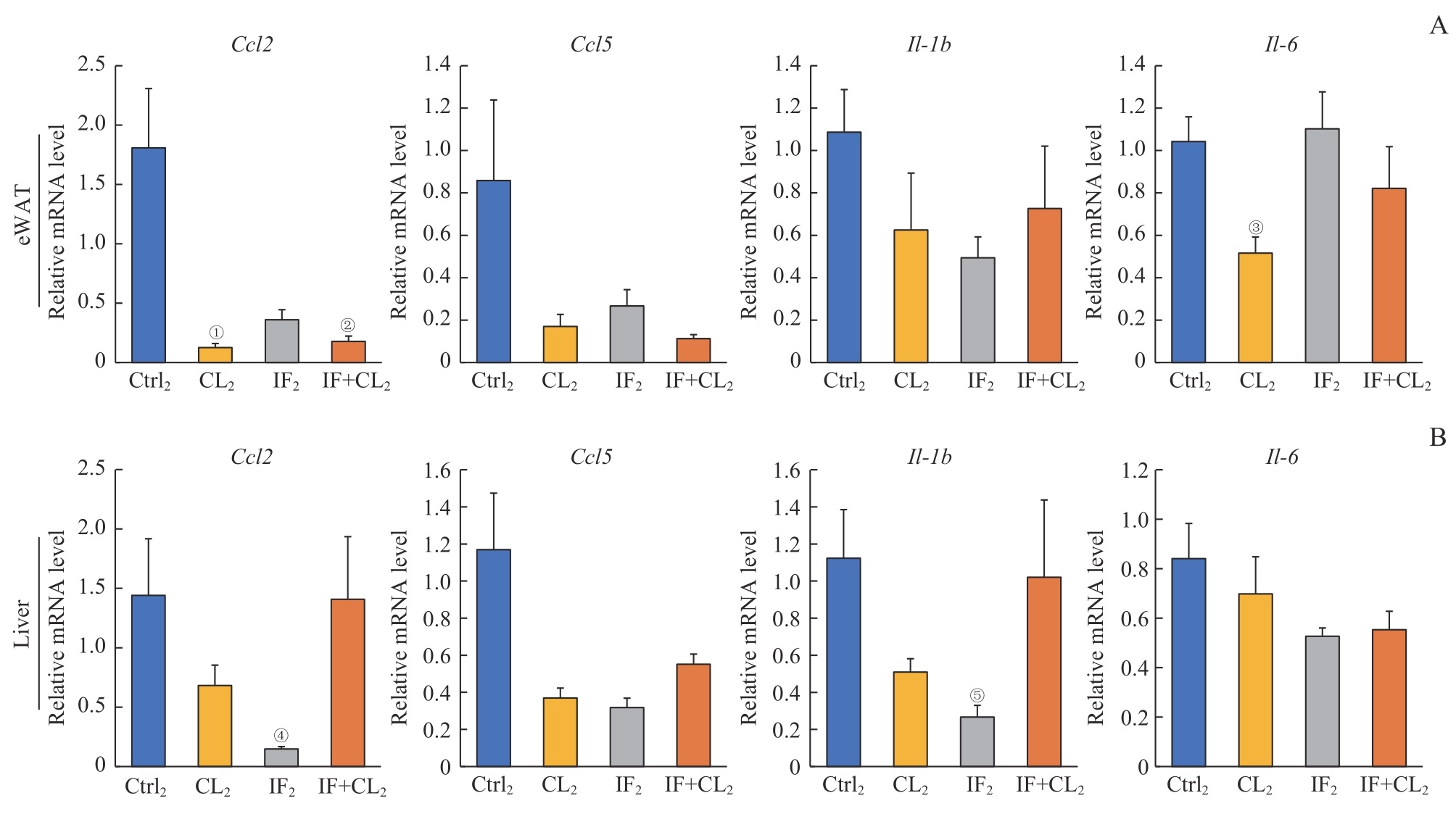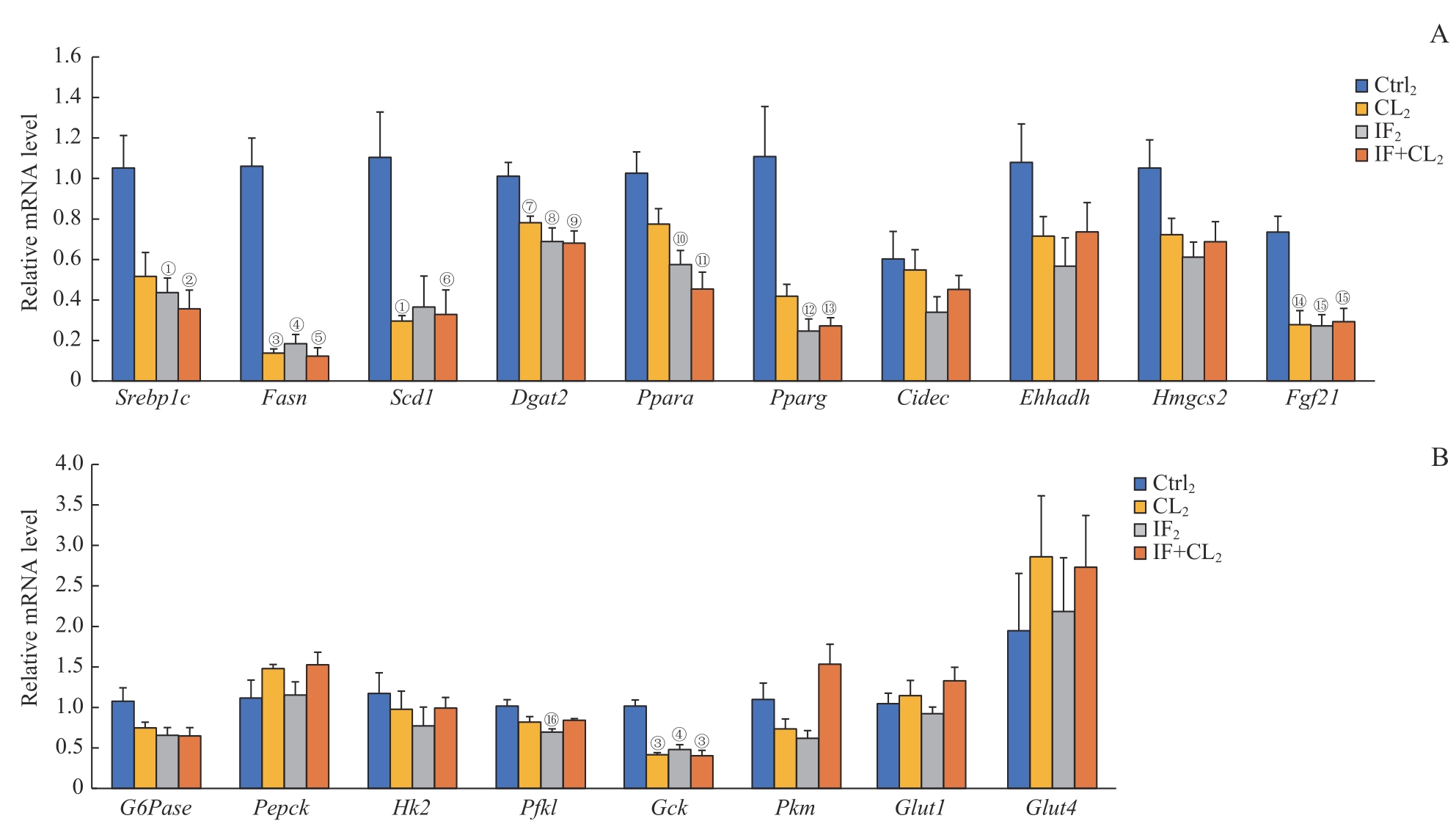
Journal of Shanghai Jiao Tong University (Medical Science) ›› 2023, Vol. 43 ›› Issue (9): 1131-1144.doi: 10.3969/j.issn.1674-8115.2023.09.007
• Basic research • Previous Articles Next Articles
WU Kaimin1( ), MA Jing1(
), MA Jing1( ), ZHAO Xuyun2(
), ZHAO Xuyun2( )
)
Received:2023-04-06
Accepted:2023-09-03
Online:2023-09-28
Published:2023-09-28
Contact:
MA Jing,ZHAO Xuyun
E-mail:kaimin_wu2019@163.com;majing3436@163.com;xuyunzhao@shsmu.edu.cn
Supported by:CLC Number:
WU Kaimin, MA Jing, ZHAO Xuyun. Combined effects of intermittent fasting and thermogenic fat activation on the treatment and prevention of obesity in mice[J]. Journal of Shanghai Jiao Tong University (Medical Science), 2023, 43(9): 1131-1144.
Add to citation manager EndNote|Ris|BibTeX
URL: https://xuebao.shsmu.edu.cn/EN/10.3969/j.issn.1674-8115.2023.09.007
| Gene | Forward sequence (5′→3′) | Reverse sequence (5′→3′) |
|---|---|---|
| Rplp0 | GAAACTGCTGCCTCACATCCG | GCTGGCACAGTGACCTCACACG |
| Ccl2 | AGGTCCCTGTCATGCTTCTG | TCTGGACCCATTCCTTCTTG |
| Ccl5 | TGCCCACGTCAAGGAGTATTT | TTCTCTGGGTTGGCACACACT |
| Il-1b | GAAATGCCACCTTTTGACAGTG | TGGATGCTCTCATCAGGACAG |
| Il-6 | AGTTGCCTTCTTGGGACTGA | TCCACGATTTCCCAGAGAAC |
| Ucp1 | GGCATTCAGAGGCAAATCAGCT | CAATGAACACTGCCACACCTC |
| Cidea | GCAGCCTGCAGGAACTTATCAGC | GATCATGAAATGCGTGTTGTCC |
| leptin | AGCAGTGCCTATCCAGAA | TGCCAGAGTCTGGTCCATCT |
| adiponectin | CAACTGAAGAGCTAGCTC | CTTAGGACCAAGAAGACCTG |
| Ppara | AGAGCCCCATCTGTCCTCTC | ACTGGTAGTCTGCAAAACCAAA |
| Pparg | CTGACCCAATGGTTGCTGAT | GGTGGAGATGCAGGTTCTAC |
| Ehhadh | CAGATGAAGCACTCAAGCTTG | ACCTTGGCAATGGCTTCTGCA |
| Hmgcs2 | GACATCAACTCCCTGTGCCTG | GATGTCAGTGTTGCCTGAATC |
| Cidec | TCGACCTGTACAAGCTGAACCCT | AGGTGCCAAGCAGCATGTGACC |
| Srebp1c | GATGTGCGAACTGGACACAG | CATAGGGGGCGTCAAACAG |
| Fasn | GGAGGTGGTGATAGCCGGTAT | TGGGTAATCCATAGAGCCCAG |
| Scd1 | GCTGGAGTACGTCTGGAGGAA | TCCCGAAGAGGCAGGTGTAG |
| Dgat2 | GCGCTACTTCCGAGACTACTT | GGGCCTTATGCCAGGAAACT |
| Gck | AGGAGGCCAGTGTAAAGATGT | CTCCCAGGTCTAAGGAGAGAAA |
| Pfkl | TCCGCACCTACAACATCCAC | GGCTGGGATGACACACATGA |
| Hk2 | TGATCGCCTGCTTATTCACGG | AACCGCCTAGAAATCTCCAGA |
| Pkm | GCCGCCTGGACATTGACTC | CCATGAGAGAAATTCAGCCGAG |
| Glut1 | TCAAACATGGAACCACCGCTA | AAGAGGCCGACAGAGAAGGAA |
| Glut4 | GTGACTGGAACACTGGTCCTA | CCAGCCACGTTGCATTGTAG |
| Pepck | CATATGCTGATCCTGGGCATAAC | CAAACTTCATCCAGGCAATGTC |
| G6Pase | ACACCGACTACTACAGCAACAG | CCTCGAAAGATAGCAAGAGTAG |
Tab 1 Primer sequences for RT-qPCR
| Gene | Forward sequence (5′→3′) | Reverse sequence (5′→3′) |
|---|---|---|
| Rplp0 | GAAACTGCTGCCTCACATCCG | GCTGGCACAGTGACCTCACACG |
| Ccl2 | AGGTCCCTGTCATGCTTCTG | TCTGGACCCATTCCTTCTTG |
| Ccl5 | TGCCCACGTCAAGGAGTATTT | TTCTCTGGGTTGGCACACACT |
| Il-1b | GAAATGCCACCTTTTGACAGTG | TGGATGCTCTCATCAGGACAG |
| Il-6 | AGTTGCCTTCTTGGGACTGA | TCCACGATTTCCCAGAGAAC |
| Ucp1 | GGCATTCAGAGGCAAATCAGCT | CAATGAACACTGCCACACCTC |
| Cidea | GCAGCCTGCAGGAACTTATCAGC | GATCATGAAATGCGTGTTGTCC |
| leptin | AGCAGTGCCTATCCAGAA | TGCCAGAGTCTGGTCCATCT |
| adiponectin | CAACTGAAGAGCTAGCTC | CTTAGGACCAAGAAGACCTG |
| Ppara | AGAGCCCCATCTGTCCTCTC | ACTGGTAGTCTGCAAAACCAAA |
| Pparg | CTGACCCAATGGTTGCTGAT | GGTGGAGATGCAGGTTCTAC |
| Ehhadh | CAGATGAAGCACTCAAGCTTG | ACCTTGGCAATGGCTTCTGCA |
| Hmgcs2 | GACATCAACTCCCTGTGCCTG | GATGTCAGTGTTGCCTGAATC |
| Cidec | TCGACCTGTACAAGCTGAACCCT | AGGTGCCAAGCAGCATGTGACC |
| Srebp1c | GATGTGCGAACTGGACACAG | CATAGGGGGCGTCAAACAG |
| Fasn | GGAGGTGGTGATAGCCGGTAT | TGGGTAATCCATAGAGCCCAG |
| Scd1 | GCTGGAGTACGTCTGGAGGAA | TCCCGAAGAGGCAGGTGTAG |
| Dgat2 | GCGCTACTTCCGAGACTACTT | GGGCCTTATGCCAGGAAACT |
| Gck | AGGAGGCCAGTGTAAAGATGT | CTCCCAGGTCTAAGGAGAGAAA |
| Pfkl | TCCGCACCTACAACATCCAC | GGCTGGGATGACACACATGA |
| Hk2 | TGATCGCCTGCTTATTCACGG | AACCGCCTAGAAATCTCCAGA |
| Pkm | GCCGCCTGGACATTGACTC | CCATGAGAGAAATTCAGCCGAG |
| Glut1 | TCAAACATGGAACCACCGCTA | AAGAGGCCGACAGAGAAGGAA |
| Glut4 | GTGACTGGAACACTGGTCCTA | CCAGCCACGTTGCATTGTAG |
| Pepck | CATATGCTGATCCTGGGCATAAC | CAAACTTCATCCAGGCAATGTC |
| G6Pase | ACACCGACTACTACAGCAACAG | CCTCGAAAGATAGCAAGAGTAG |

Fig 7 Preventive effect of intermittent fasting combined with thermogenic fat activation on high-fat diet-induced fat deposition in the fat and liver tissues

Fig 8 Preventive effect of intermittent fasting combined with thermogenic fat activation on high-fat diet-induced inflammation in the fat and liver tissues

Fig 10 Effect of intermittent fasting combined with thermogenic fat activation on glucose and lipid metabolism in the liver tissue of mice on a high-fat diet
| 1 | WANG W S, SEALE P. Control of brown and beige fat development[J]. Nat Rev Mol Cell Biol, 2016, 17(11): 691-702. |
| 2 | HARMS M, SEALE P. Brown and beige fat: development, function and therapeutic potential[J]. Nat Med, 2013, 19(10): 1252-1263. |
| 3 | SAKERS A, DE SIQUEIRA M K, SEALE P, et al. Adipose-tissue plasticity in health and disease[J]. Cell, 2022, 185(3): 419-446. |
| 4 | WOLFRUM C, GERHART-HINES Z. Fueling the fire of adipose thermogenesis[J]. Science, 2022, 375(6586): 1229-1231. |
| 5 | HAO L, SCOTT S, ABBASI M, et al. Beneficial metabolic effects of mirabegron in vitro and in high-fat diet-induced obese mice[J]. J Pharmacol Exp Ther, 2019, 369(3): 419-427. |
| 6 | PERES VALGAS DA SILVA C, CALMASINI F, ALEXANDRE E C, et al. The effects of mirabegron on obesity-induced inflammation and insulin resistance are associated with brown adipose tissue activation but not beiging in the subcutaneous white adipose tissue[J]. Clin Exp Pharmacol Physiol, 2021, 48(11): 1477-1487. |
| 7 | FINLIN B S, MEMETIMIN H, ZHU B B, et al. The β3-adrenergic receptor agonist mirabegron improves glucose homeostasis in obese humans[J]. J Clin Invest, 2020, 130(5): 2319-2331. |
| 8 | O'MARA A E, JOHNSON J W, LINDERMAN J D, et al. Chronic mirabegron treatment increases human brown fat, HDL cholesterol, and insulin sensitivity[J]. J Clin Invest, 2020, 130(5): 2209-2219. |
| 9 | PUTMAN A K, CONTRERAS G A, MOTTILLO E P. Thermogenic adipose redox mechanisms: potential targets for metabolic disease therapies[J]. Antioxidants (Basel), 2023, 12(1): 196. |
| 10 | VARADY K A, CIENFUEGOS S, EZPELETA M, et al. Clinical application of intermittent fasting for weight loss: progress and future directions[J]. Nat Rev Endocrinol, 2022, 18(5): 309-321. |
| 11 | CATENACCI V A, PAN Z X, OSTENDORF D, et al. A randomized pilot study comparing zero-calorie alternate-day fasting to daily caloric restriction in adults with obesity[J]. Obesity (Silver Spring), 2016, 24(9): 1874-1883. |
| 12 | VARADY K A, BHUTANI S, KLEMPEL M C, et al. Alternate day fasting for weight loss in normal weight and overweight subjects: a randomized controlled trial[J]. Nutr J, 2013, 12(1): 146. |
| 13 | HARVIE M N, PEGINGTON M, MATTSON M P, et al. The effects of intermittent or continuous energy restriction on weight loss and metabolic disease risk markers: a randomized trial in young overweight women[J]. Int J Obes (Lond), 2011, 35(5): 714-727. |
| 14 | LIU D Y, HUANG Y, HUANG C, et al. Calorie restriction with or without time-restricted eating in weight loss[J]. N Engl J Med, 2022, 386(16): 1495-1504. |
| 15 | CHO A R, MOON J Y, KIM S, et al. Effects of alternate day fasting and exercise on cholesterol metabolism in overweight or obese adults: a pilot randomized controlled trial[J]. Metabolism, 2019, 93: 52-60. |
| 16 | TREPANOWSKI J F, KROEGER C M, BARNOSKY A, et al. Effect of alternate-day fasting on weight loss, weight maintenance, and cardioprotection among metabolically healthy obese adults: a randomized clinical trial[J]. JAMA Intern Med, 2017, 177(7): 930-938. |
| 17 | KLEMPEL M C, BHUTANI S, FITZGIBBON M, et al. Dietary and physical activity adaptations to alternate day modified fasting: implications for optimal weight loss[J]. Nutr J, 2010, 9: 35. |
| 18 | DE CABO R, MATTSON M P. Effects of intermittent fasting on health, aging, and disease[J]. N Engl J Med, 2019, 381(26): 2541-2551. |
| 19 | LIU B, PAGE A J, HUTCHISON A T, et al. Intermittent fasting increases energy expenditure and promotes adipose tissue browning in mice[J]. Nutrition, 2019, 66: 38-43. |
| 20 | MARINHO T S, ORNELLAS F, AGUILA M B, et al. Browning of the subcutaneous adipocytes in diet-induced obese mouse submitted to intermittent fasting[J]. Mol Cell Endocrinol, 2020, 513: 110872. |
| 21 | LI G, XIE C, LU S, et al. Intermittent fasting promotes white adipose browning and decreases obesity by shaping the gut microbiota[J]. Cell Metab, 2017, 26(4): 672-685.e4. |
| 22 | HEPLER C, WEIDEMANN B J, WALDECK N J, et al. Time-restricted feeding mitigates obesity through adipocyte thermogenesis[J]. Science, 2022, 378(6617): 276-284. |
| 23 | YONESHIRO T, AITA S, MATSUSHITA M, et al. Brown adipose tissue, whole-body energy expenditure, and thermogenesis in healthy adult men[J]. Obesity (Silver Spring), 2011, 19(1): 13-16. |
| 24 | SPONTON C H, DE LIMA-JUNIOR J C, LEIRIA L O. What puts the heat on thermogenic fat: metabolism of fuel substrates[J]. Trends Endocrinol Metab, 2022, 33(8): 587-599. |
| 25 | EZPELETA M, GABEL K, CIENFUEGOS S, et al. Effect of alternate day fasting combined with aerobic exercise on non-alcoholic fatty liver disease: a randomized controlled trial[J]. Cell Metab, 2023, 35(1): 56-70.e3. |
| 26 | GUREVICH-PANIGRAHI T, PANIGRAHI S, WIECHEC E, et al. Obesity: pathophysiology and clinical management[J]. Curr Med Chem, 2009, 16(4): 506-521. |
| 27 | BEL J S, TAI T C, KHAPER N, et al. Mirabegron: the most promising adipose tissue beiging agent[J]. Physiol Rep, 2021, 9(5): e14779. |
| [1] | HUANG Zhouxuan, SHAO Jingbo. Research progress in the treatment of chronic primary immune thrombocytopenia [J]. Journal of Shanghai Jiao Tong University (Medical Science), 2025, 45(4): 508-516. |
| [2] | ZHOU Zhiyi, ZHAO Hao, MIAO Yifeng, ZHU Chihao, YANG Xi, WANG Siyuan, FENG Junfeng, QIU Yongming. Application of full-neuroendoscopic technique in surgical treatment of posterior cranial fossa lesions [J]. Journal of Shanghai Jiao Tong University (Medical Science), 2025, 45(3): 365-372. |
| [3] | SONG Yijie, CHEN Tianzhen, ZHONG Na, ZHAO Min. Applications and challenges of generative artificial intelligence in psychiatry [J]. Journal of Shanghai Jiao Tong University (Medical Science), 2025, 45(10): 1271-1278. |
| [4] | DU Fang, ZHOU Lingyun, CHEN Jiao, LIU Danbo, XIANG Hongxian, CHEN Haifei. A case report of relapsed and refractory multiple myeloma with multifocal extramedullary infiltration and pulmonary adenocarcinoma [J]. Journal of Shanghai Jiao Tong University (Medical Science), 2025, 45(1): 122-128. |
| [5] | KANG Piao, ZHANG Ying, LI Huating. Research progress in food preferences mechanisms and their impact on obesity [J]. Journal of Shanghai Jiao Tong University (Medical Science), 2024, 44(9): 1190-1196. |
| [6] | LI Yibai, CUI Ruiji, GAO Shan, HU Jiajin, GUO Xiaoying. Research progress in late-onset group B Streptococcus infection in infants and its prevention [J]. Journal of Shanghai Jiao Tong University (Medical Science), 2024, 44(8): 1044-1049. |
| [7] | CHEN Shentse, CHEN Yiming, WANG Fan, ZHANG Mengke, YANG Weichieh, LÜ Dongbin, HONG Wu. Advances in dietary interventions for the treatment of depression-related symptoms [J]. Journal of Shanghai Jiao Tong University (Medical Science), 2024, 44(8): 1050-1055. |
| [8] | LÜ Qinyi, GAO Ziqi, FENG Qingchen, MEI Hongxiang, LI Juan. Optimizing arch expansion with clear aligners in the mixed dentition based on finite element analysis [J]. Journal of Shanghai Jiao Tong University (Medical Science), 2024, 44(8): 935-943. |
| [9] | GUO Yonglin, CHEN Moxin, LIU Zheyuan, LI Yifei, WANG Ziqi, SHU Qin, LI Lin. Progress in diagnosis and treatment of strabismus based on artificial intelligence technology [J]. Journal of Shanghai Jiao Tong University (Medical Science), 2024, 44(3): 393-398. |
| [10] | LIU Meiling, ZHOU Yabing, WANG Xiaoqiang. Advances in the treatment of intracranial neoplastic lesions in children with neurofibromatosis 1 [J]. Journal of Shanghai Jiao Tong University (Medical Science), 2024, 44(3): 399-406. |
| [11] | JIANG Shuang, YU Jiwei. Progress of research on m6A demethylases in gastric cancer [J]. Journal of Shanghai Jiao Tong University (Medical Science), 2024, 44(2): 271-277. |
| [12] | CHEN Zixuan, LIU Min. Progress in mechanisms and treatment of sunitinib resistance in renal cell carcinoma [J]. Journal of Shanghai Jiao Tong University (Medical Science), 2024, 44(10): 1307-1315. |
| [13] | ZHU Kaiyuan, SU Yuchen, LIU Zhichao, ZHANG Hong, LI Chunguang, ZHANG Jie, LI Zhigang. Adjuvant strategies for patients with T1b invasion after endoscopic submucosal dissection for esophageal squamous cell carcinoma [J]. Journal of Shanghai Jiao Tong University (Medical Science), 2024, 44(1): 116-123. |
| [14] | WU Qian, LI Huating. Progress of olfactory changes in metabolic diseases and the mechanisms [J]. Journal of Shanghai Jiao Tong University (Medical Science), 2024, 44(1): 131-136. |
| [15] | LU Xiaobing, YUE Jiang, HE Shengyun, DONG Ying, LU Qing, MA Jing. Effect of intramuscular adipose tissue in the skeletal muscle of thigh on glucose metabolism in male patients with obesity [J]. Journal of Shanghai Jiao Tong University (Medical Science), 2023, 43(9): 1169-1174. |
| Viewed | ||||||
|
Full text |
|
|||||
|
Abstract |
|
|||||